Polonnaruwa
| Polonnaruwa පොළොන්නරුව | |
|---|---|
| Town | |
|
Royal Palace | |
| Nickname(s): පුලතිසිපුරය | |
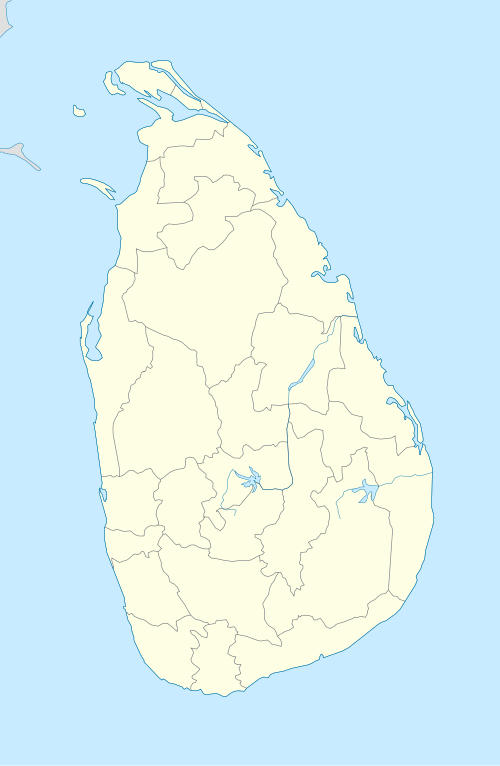 Polonnaruwa පොළොන්නරුව Location in Sri Lanka | |
| Coordinates: 7°56′N 81°0′E / 7.933°N 81.000°ECoordinates: 7°56′N 81°0′E / 7.933°N 81.000°E | |
| Country | Sri Lanka |
| Province | North Central Province |
| Polonnaruwa | Before 1070 AD |
| Time zone | Sri Lanka Standard Time Zone (UTC+5:30) |
| Ancient City of Polonnaruwa | |
|---|---|
| Name as inscribed on the World Heritage List | |
 | |
| Type | Cultural |
| Criteria | i, iii, vi |
| Reference | 201 |
| UNESCO region | Asia-Pacific |
| Inscription history | |
| Inscription | 1982 (6th Session) |
Poḷonnaruwa (Sinhalese: පොලොන්නරුව, Poḷonnaruwa or Puḷattipura, Tamil: பொலன்னறுவை, Polaṉṉaṟuvai or Puḷatti nakaram) is the main town of Polonnaruwa District in North Central Province, Sri Lanka. Kaduruwela area is the Polonnaruwa New Town and the other part of Polonnaruwa remains as the royal ancient city of the Kingdom of Polonnaruwa.
The second most ancient of Sri Lanka's kingdoms, Polonnaruwa was first declared the capital city by King Vijayabahu I, who defeated Chola invaders in 1070 to reunite the country once more under a local leader.
The Ancient City of Polonnaruwa has been declared a World Heritage Site.[1]
Currently the new Polonnaruwa is undergoing a major development project known as the "Awakening of Polonnaruwa" under the concept of President Maithripala Sirisena. It envisions the development of all sectors in Polonnaruwa including roads, electricity, agriculture, education, health and environment will be developed comprehensively.[2]
History
While Vijayabahu's victory and shifting of kingdoms to the more strategic Polonnaruwa is considered significant, the real "Hero of Polonnaruwa" of the history books is actually Parakramabahu I. It was his reign that is considered the Golden Age of Polonnaruwa. Trade and agriculture flourished under the patronage of the king, who was so adamant that no drop of water falling from the heavens was to be wasted and each was to be used toward the development of the land. Hence, irrigation systems that are far superior to those of the Anuradhapura Age were constructed during Parakramabahu's reign - systems which to this day supply the water necessary for paddy cultivation during the scorching dry season in the east of the country. The greatest of these systems is the Parakrama Samudra or the Sea of Parakrama. The Kingdom of Polonnaruwa was completely self-sufficient during King Parakramabahu's reign.
With the exception of his immediate successor, Nissankamalla I, all other monarchs of Polonnaruwa were slightly weak-willed and rather prone to picking fights within their own court. They also went on to form more intimate matrimonial alliances with stronger South Indian kingdoms until these matrimonial links superseded the local royal lineage. This prompted an invasion by the Aryacakravarti dynasty King Kalinga Magha in 1214, who founded the Jaffna kingdom (1215-1624 CE). Local power passed into the hands of a Pandyan dynasty king following the Jaffna kingdom invasion of Lanka in 1284, who moved their capital to Dambadeniya. Polonnaruwa was also called Jananathamangalam during this brief period under the Pandya.
Present day
Today the ancient city of Polonnaruwa remains one of the best planned archaeological relic sites in the country, standing testimony to the discipline and greatness of the Kingdom's first rulers. Its beauty was also used as a backdrop to filmed scenes for the Duran Duran music video Save a Prayer in 1982. The ancient city of Polonnaruwa has been declared a World Heritage site by UNESCO.
Near the ancient city, there is a small town with several hotels (especially for tourists) and some glossy shops, and places to fulfill day-to-day needs. There are government institutions in a newly built area called “new town,” about 6 km away from the town and the main road. The largest school in the district, Polonnaruwa Royal Central College is situated at new town.
Polonnaruwa is the second largest city in North Central Province, but it is known as one of the cleanest and more beautiful cities in the country. The green environment, amazing ancient constructions, Parakrama Samudra (a huge lake built in 1200), and attractive tourist hotels and hospitable people, attract tourists.
Another draw for tourists is the city's population of toque macaques. The monkeys have been living in the ruins since human occupation and continue to thrive here long after the humans left. The monkeys and their environs are featured in the 2015 Disneynature film, Monkey Kingdom, which was largely filmed in Polonnaruwa.[3]
Picture gallery
 Statue of King Parakramabahu
Statue of King Parakramabahu Council Chamber
Council Chamber.jpg) Kumara Pokuna
Kumara Pokuna Shiva Dewalaya
Shiva Dewalaya Thuparama
Thuparama
 Sandakada pahana at Polonnaruwa
Sandakada pahana at Polonnaruwa

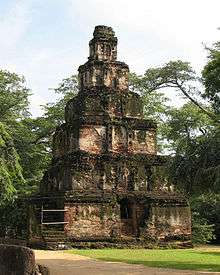 Satmahal Prasada
Satmahal Prasada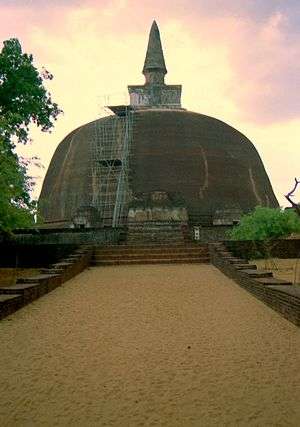
 Lankatilaka temple
Lankatilaka temple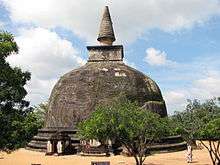 Kiri Vihara
Kiri Vihara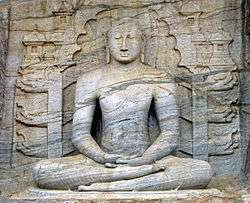 Statue at Gal Vihara
Statue at Gal Vihara
 Foggy morning & paddy field
Foggy morning & paddy field
See also
- Polonnaruwa Vatadage
- Hatadage
- Rankoth Vehera
- Nissanka Latha Mandapaya
- Gal Vihara
- World Heritage List
- Anuradhapura
- Sigiriya
- Mahawamsa
- Place names in Sri Lanka
References
- ↑ "Ancient City of Polonnaruwa". World Heritage Convention, UNESCO. Retrieved 21 May 2015.
- ↑ "President commences "Pibidemu Polonnaruwa" - The official website of the President of Sri Lanka". www.president.gov.lk. Retrieved 2015-11-16.
- ↑ http://www.imdb.com/title/tt3660770/
- Balasooriya, Jayasinghe (2004). The Glory of Ancient Polonnaruva. Polonnaruva: Sooriya Printers. ISBN 955-8158-01-1 (Archeological ruins)
- 'The Satmahal Prasada: A Historic link between Lan Na and Sri Lanka', in: Forbes, Andrew, and Henley, David, Ancient Chiang Mai Volume 1. Chiang Mai: Cognoscenti Books, 2012.
Maps
External links
| Wikimedia Commons has media related to Polonnaruwa. |
| Wikivoyage has a travel guide for Polonnaruwa. |
- Discover Sri Lanka - More information & images about Polonnaruwa
- Hotel Sudu Araliya - A Hotel in Polonnaruwa
- Ancient City of Polonnaruwa
- "Discovering Polonnaruwa" - an article in The Hindu
- Galvihara - a unique display of rock art
- Official website of the Sri Lanka Tourism Board
- A list of traditional names of cities in Sri Lanka
- Polonnaruwa - The Cultural Triangle Visitors
